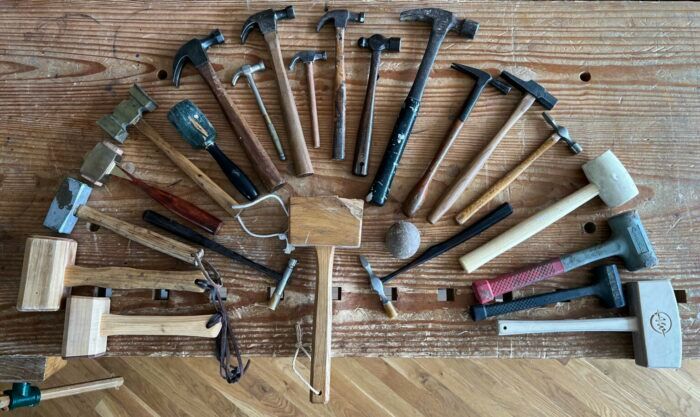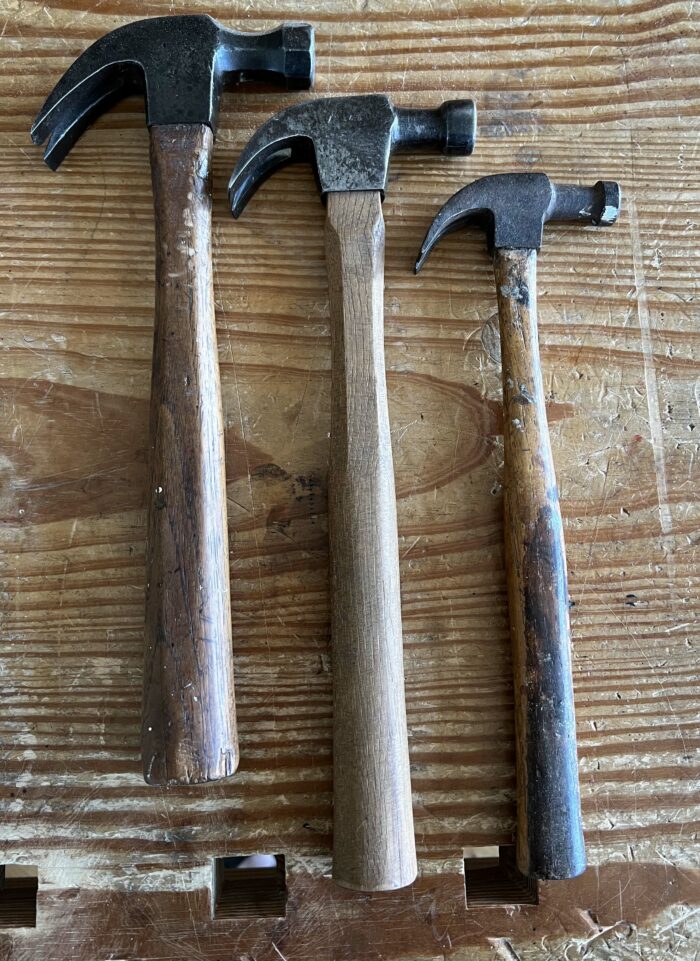Hitty things: You need four (but more are better)
Sometimes your work needs a whack. That's where hammers come in.
Any list of “must-have” hammers and mallets is subjective, but as a hand-tool woodworker who often uses nails, my list is short (despite the picture above):
• claw hammer (aka a nail-whacking hammer)
• round mallet for dovetailing (I expect disagreement here)
• heavy wooden mallet (for knocking things together and apart)
• heavy metal mallet (for knocking things together and apart when a wooden one doesn’t have enough oomph, and for hitting holdfasts)

Claw hammers
A well-balanced claw hammer is absolutely necessary, particularly if you drive a lot of nails (as I do, on myriad tool chest bottoms and backs). If you can have only one, I recommend a 16-oz. version, ideally with a wooden, faceted handle. Worn wood feels better to my hand than any modern polymer or rubber coating, and the facets help you locate how to hold it by feel. If you buy a new one, sand off the slick coating. It’ll look better and feel better with natural patina.
But there are plenty of old ones available – check out yard sales and tool meets for a pre-patinated version. And they’re cheap, so you might as well get a 12-oz. and 8-oz. claw hammer, too, for lighter work. Using a heavy hammer for light work will be more tiring than it needs to be; the reverse is also true. And while there are heavier hammers available (they’ll more likely be framing hammers, aka ripping hammers with a straight claw), you don’t really need that for furniture work. Save the weight for a “lump hammer” instead (see below).

If you prefer an English or European tradition, you might go for a Warrington-pattern hammer instead, with its cross-peen/pein/pane for getting small nails started. My problem with this hammer type, though, is finding my nail-puller if I need to get a nail back out. That said, I do find this style useful, especially when attaching escutcheons and other small things. For me, it’s a “nice to have” rather than a “must-have.”

Round mallets
My go-to dovetail mallet is a 16-oz. round mallet. The head is polymer-infused maple; the handle is blackwood. Yes, I bought it (in 2009) because it’s blue – but that’s not the only reason I love it.
I know many people prefer a square mallet with a flat face for dovetailing, because they can get more reliable force on the mallet. The argument is that the round face can more easily glance off the (possibly also rounded) chisel handle end, thereby lessening the force of the blow. My argument is that with a round mallet, I don’t have to think about the face; it’s all one big face. No matter how I pick it up or with which what part of the head I hit the chisel, I’ll be hitting it with the striking face of my mallet. And no, it does not roll off the bench, because I set it down on its flat end.
Wooden mallets
Regardless of whether your chisel mallet is round or square, in my opinion it should be wood. I can’t stand rubber mallets for dovetailing; they bounce off the end of the chisel (yes, even dead-blow hammers), and don’t give proper feedback to my hands.
All that said, I’m sure the best dovetailing mallet for you is the one you’re used to. So if you’re just getting started with dovetails, start out right … get a round wooden mallet! (And if you come to one of my classes with a rubber mallet, I will try my best to not ridicule you. I will fail.)

A heavy wooden mallet is a must. I know some folks – folks much stronger than I – who use a heavy wooden mallet for dovetailing. My wrists can’t take that kind of abuse, but I do use the one above when assembling dovetails. That’s where it shines: in knocking together and knocking apart casework. Theoretically, the leather-faced surface on this one helps to protect the work, but I also put a scrap in between the mallet and the work when knocking it together. The one shown is a 24-oz. “Rectangular Mallet” from Blue Spruce Toolworks. We ordered it the day or day after Blue Spruce founder Dave Jeske first wrote about it; it’s so covered in grime and dried glue from years of use that, with the leather strap removed, it now weighs 27 oz. (I’m kidding … sort of. The weight is nominal; it has probably always weighed a bit more than 24 oz. But there really is a lot of grimy glue on the handle.)

Metal mallets
And finally, in my cadre of four must-have hitty things, is a lump hammer, which is also known as a small sledge hammer. The majority of my workholding on the bench is done with holdfasts, so I need a heavy hammer that can seat the holdfast firmly with one good smack on its top, and release it with one good smack on its neck. My lump hammer also gets used a lot when knocking together casework, especially in classes when folks are moving just a hair too slowly and the glue has started to set up before dovetails are fully seated. (Using it for this purpose always makes me smile, because I hear in my head the inimitable Frank Klausz saying, “get a bigger hammer.”)

So there you have it – the four hitty things I think you simply must have. (But it sure is nice to have at least 20 more, going by the picture at the top!)
More by Megan Fitzpatrick
 |
How’s it hangin’? (Your dovetail saw, I mean) |
 |
My lands! You shouldn’t buy just any chisels |
 |
On nails |
Fine Woodworking Recommended Products

Lie-Nielsen No. 102 Low Angle Block Plane

Starrett 12-in. combination square

Olfa Knife






















Comments
I took a couple of pictures a few years ago, trying to assemble what I could find. This is because I had 2 houses, two shops, a garage, a truck, etc. Still, lots of hitty things. And I have several more since.
You have me beat. By a large margin.
I caused my dad a calamity 20ish years ago. I bought him the then new Stanley vibration handle dampened hammer (i.e. had what looked like a tuning fork built into the handle). It didn't fit on his pegboard area where all of the other hammers were. Resulted in a massive reorg of his peg board. All my fault :-)
Wow, Those are my choices, too!! Except I made my round and heavy mallets out of a fallen maple branch and hickory respectively.
I love a heavy rawhide hammer for setting holdfasts. Quieter than the lump and just as oomphy.
Here are my most used hitty things. I have another drawer that are less used.
Thanks Megan. This blog made me go look at my tools just to see how many hitty things I use.
1. Claw hammer which I've had since the 1980s and is mostly used for household stuff.
2. The Thor style hammer Paul Sellers likes for chisel work and assembly. I really like it and I have tried a few others.
3. A Warrington style hammer for driving nails in my fine woodworking.
4. A dainty Warrington style hammer I bought from LieNielsen (after I saw it being used at a LieNielsen tool show). I dig this hammer. I use it for the fine lateral adjustment of my blade in my hand planes. I find it easier to laterally adjust the blade with this dainty hammer than using the lateral adjustor.
5. A lump style hammer my dad purchased for me in the 1990s/early 2000s. I use it mostly to strike my maker's mark in my woodwork.
So I guess my number is 5. I have others but really these are the ones I use. I totally get why people collect hammers and vintage used ones sell briskly.
I do love my plane-adjusting hammer...just don't consider it am imperative (because I'll use whatever is handy to tap the blade – sometimes a hammer-shaped object, sometimes a screwdriver handle...)
What about the 5th type? The "I'm not going to walk all 7 feet to the toolbox so I'll grab whatever is close and start swinging" hammer?
You know, let's just bash whatever needs bashing with the blunt end of a clamp, scrap 2x4, or screwdriver handle because of its proximity.
More Megan articles please! Also curious where I can find a new well balanced nail-pulling hammer vs the demo-ing hammers of today.
A 5th “hitty thing” is needed for carving. Just as a square mallet is too heavy for dovetailing, the round mallet used for dovetailing is too heavy (usually) for carving. A light, round mallet is needed (or at least is very very useful) for carving.
Log in or create an account to post a comment.
Sign up Log in